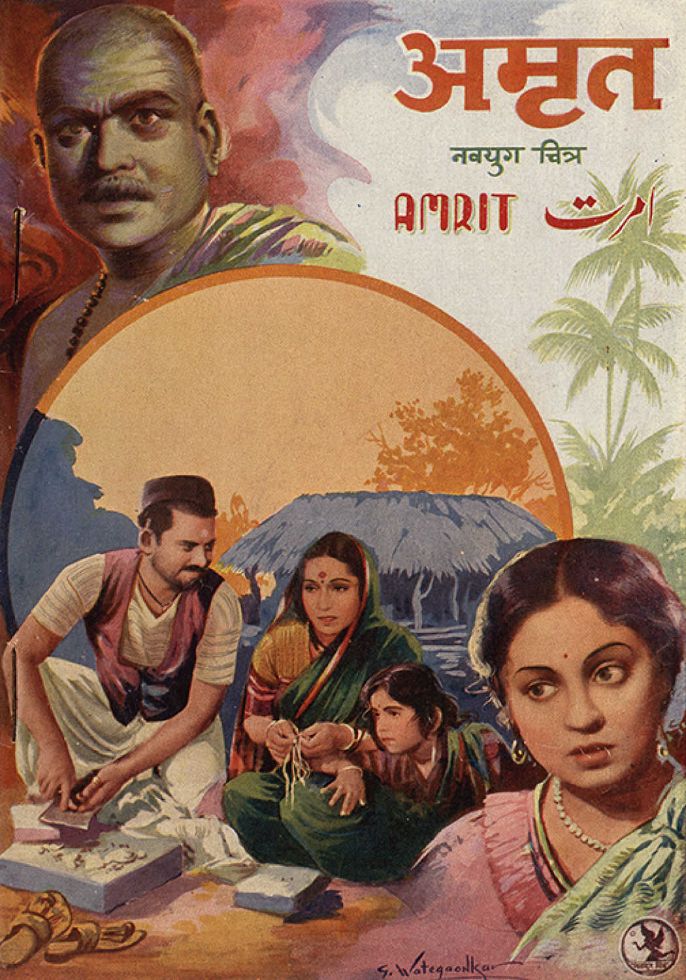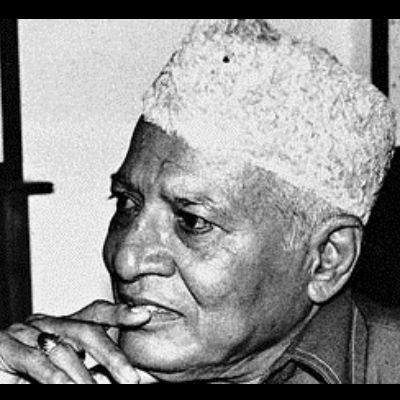“Amrit” Becomes A First Class Picture
29 Aug, 2020 | Archival Reproductions by Cinemaazi

Image credit: Cinestaan
Subscribe to read full article
This section is for paid subscribers only. Our subscription is only $37/- for one full year.
You get unlimited access to all paid section and features on the website with this subscription.
Not ready for a full subscription?
You can access this article for $2, and have it saved to your account for one year.
Lalita Pawar and Baburao Pendharkar Shine
An Entertaining & Instructive Picture
The picture opens with a very high flown ideal of “God creating the world and expecting the human beings to live in it in a loving brother-hood etc., etc., and then suddenly the theme deteriorates and dissolves itself into a prohibition campaign against toddy and liquor drinking.An Entertaining & Instructive Picture
Khandekar’s erratic treatment of film plots is not new to us, but in this one, he scores a remarkable hit by thinking of one thing and writing about another, so completely different. It is the directorial genius of Vinayak that saves Khandekar from himself.
The name “Amrit” is the least consistent part of the picture which should have been called “Jamuna, Chamarin.” The picture would then have secured a little more human appeal.
A STUPID PROCEDURE
The story cannot be told in detail here because the names of the characters are different in the two versions, Marathi and Hindusthani. This is at best a stupid practice which only helps in revealing to us the bankruptcy of brains in the writers who, it seems, cannot find names which can be common and yet popular for both the versions. If these different names are given to
Stress the individuality of the version writers, it is a regrettably stupid indulgence in conceit which only helps to create confusion. I shall therefore relate the story in symbols and signs. There is a rich landowner with as a daughter and a friend of the son thrown as grace on this side. On the other side of the fence are a shoe-maker, his beautiful wife and a smart little daughter. The first party is rich and the second party is poor. The second party, moreover, is addicted to drinks thereby giving the son of the first party a chance to make some indecent proposals to the wife of the second party.
But the wife of the second party spurns the man inspite of her own husband being irresponsible.
The name “Amrit” is the least consistent part of the picture which should have been called “Jamuna, Chamarin.” The picture would then have secured a little more human appeal.
THREE-IN-ONE AFFAIR.
The story seems to be having three themes—(1) an illegitimate romancing between the rich man and the poor beautiful woman (2) pointing out the social evil of drinking, (3) and the eternal clash between the rich and the poor. The original paper theme of “God creating a world etc., etc.,” dies with the title. And the three themes which rush in and out of the reels never catch up with their justification completely at any stage.
The prohibition scenes are made unreal the dramatic and look very exaggerated. The song sung by the toddy drunkards popularizes toddy drinking. If toddy drinking people can sing so well after all the toddy that is sent in, it is not at all a bad job drinking toddy. The song, therefore, fails in its desired effect.
Vinayak and Meenaxi are absolutely unnecessary for the main story. In fact, they could have been entirely removed and the story would have improved considerably. In the direction of Meenaxi and himself, Vinayak commits the very same mistake which Shantaram has committed in Shejari (1941). For some reason best known to Vinayak, Meenaxi’s scenes are unnecessarily pulled out and made boring. If the idea was to put Meenaxi on the screen as much as possible to make her more popular, it has failed in its purpose as Meenaxi, having no logical existence in the whole plot, becomes, at best, a drag on the otherwise fast tempo of the story.
VINAYAK ON SUICIDE PATH.
The love antics of Meenaxi and Vinayak cannot be called acting. Their sequences at best become a crude pantomime of sex-starvation certainly a poor show for an intellectual like Vinayak. Vinayak must make up his mind whether he wants to produce a picture for its own sake or for the joint interests of Meenaxi and himself. He is falling into an easy rut that leads to the suicide of a career.
Meenaxi is the sex-starved daughter of the rich Hindu landlord, evidently from one of those so-called higher communities. She is a grown-up woman, who is shown as tickling her sex with some suggestive paintings. Imagine her-a Hindu eligible girl-singing a song of her empty bed and herself thirsting for a mate. The song, Meri Suni Sej Pady is vulgar and suggestive. Its Marathi version, however, is thankfully toned down.
The whole picture is shot in delightfully pleasant and rural surroundings which by their very natural grandeur take the vote spectators.
Reverting to the story, the landlord of the first party is found exploiting the poor people of the village. Idioms and parables of social philosophy soon fill the air like sparks but they fail to light up anything. All the social philosophy is wasted as the drama centres mainly round the individuals and fail to touch the community. The theme. The problem or the intention, whatever it is, that inspires the picture does not go beyond the embryo.
The rich son’s romantic leanings for the poor shoemaker's wife are soon turned by the crafty poor into an expose which brings the rich landlord to his knees. Quite too suddenly, this man who had amassed money all his life by hook or crook. turns the corner and becomes a different man. And for this a convenient storm is used, a little child is sacrificed and the face of Shiva’s image is also lighted by the lightening. Nowhere are the intrinsic truths in the philosophy given a chance to convince or convert the man who had to be made human by storms, sacrifices and other melodrama.
As is expected, the story ends with good cheer for all.
A DIRECTOR’S PICTURE.
Forgetting for a while the fundamental defects in the story, which are all of the story writers creation. The director has done a really swell job of it all by lending it a fast cinematic tempo, particularly in the last six reels, and in maintaining audience interest by dovetailing entertainment and melodrama. It is a director’s picture every inch of it, and quite his very own in the first four reels where Vinayak and Meenaxi give some mixed sex-play.
The photography is decidedly beautiful, particularly the artistic framing of the outdoor shots. The whole picture is shot in delightfully pleasant and rural surroundings which by their very natural grandeur take the vote spectators.
The first five reels called for a little more care in sound recording.
VINAYAK AND MEENAXI DISAPPOINT.
There is little to choose between Lalita Pawar and Baburao Pendharkar. Both are superb and well cast and well-matched. Salvi comes close to giving an excellent performance as the rich landlord. The disappointments of the show, however, are Vinayak and Meenaxi. They were in the picture without any reason for their stupid performance. Both seem to have forgotten to act and keep on looking at each other a little too much and a little too affectionately.
And yet, after all, done and said, “Amrit” still remains a first-class picture and as there is plenty to entertain and to learn in those fifteen reels of celluloid, you cannot afford to miss this picture.
This article is a reproduction of the review published in Film India in July 1941.
About the Author
Other Articles by Cinemaazi
17 Feb,2024
What is a Good Documentary Film?
25 Jan,2024
Salute to an Immortal Spirit
22 Jan,2024
A Painful Parting
29 Nov,2023
Children's Film Society
28 Oct,2023
Let's Give the Kids a Chance
26 Oct,2023
Directing the Child Actor
25 Oct,2023
Chandu - The Elephant Boy
23 Oct,2023
HEROISM-Children's Film Society gives the lead
18 Oct,2023
Munna
29 Sep,2023
ख्वाजा अहमद अब्बास का पत्र महात्मा गांधी के नाम
02 Sep,2023
Shakti Kapoor: It's Three Punches A Day
04 Jul,2023
Should a Filmmaker be Original?
24 Jun,2023
Babita My First Screen Love
22 Jun,2023
Phir Wohi Dil Laya Hoon
19 Jun,2023
Romance in Our Cinema
12 Jun,2023
The Romance of our Show Houses
12 Jun,2023
Kashmir Ki Kali (1964)
07 Jun,2023
Sangam (1964)
05 Jun,2023
This thing called Love
25 May,2023
Gandhi: Whose voice?
15 May,2023
"Deewar" Becomes a Nation's Prayer
15 May,2023
Mangal Pandey
06 May,2023
History of Cinema, History of the Nation
02 May,2023
Birbal Paristan Mein
20 Apr,2023
Reincarnation... the story goes on ever after
27 Mar,2023
The Film Director?
21 Mar,2023
M Sadiq
15 Mar,2023
The Social Role of the Cinema
15 Mar,2023
"Samaj" A Memorable Film with Popular Appeal
01 Mar,2023
"Two Eyes" in Hollywood
20 Feb,2023
Do Dooni Chaar
15 Feb,2023
Rafoo Chakkar
07 Feb,2023
Johnny Walker.... still going strong
20 Jan,2023
Mahabharat : Epic Tamasha
10 Jan,2023
Narsi Bhagat : An Excellent Biography
03 Jan,2023
Nav Ratri
01 Dec,2022
एक ताजगी का नाम है देवानन्द (Dev Anand)
25 Nov,2022
जे बी एच वाडिया (J B H Wadia) - वचन न जाए
14 Nov,2022
Children's Films in India
01 Sep,2022
Horses .... Cars and Laughs-Mehmood
06 Aug,2022
हिन्दी फिल्मों की दुर्दशा का जिम्मेदार कौन?
01 Aug,2022
क्या हिंदी फिल्मों से हास्य गायब हो रहा है?
20 Jul,2022
हास्य की परंपरा और हास्य अभिनेताओं की भूमिका
12 Jul,2022
प्राण और उनकी दाढ़ियाँ
17 Feb,2022
Odds Against a New Comer
10 Dec,2021
Speaking of Portraits and People
03 Nov,2021
An Actor Prepares
19 Oct,2021
Producers' War on Dubbed Films
24 Aug,2021
Jottings from a Film Director's Notebook
26 Jul,2021
प्रेमचंद सत्यजीत राय और ’सद्गति’ -गिरिजाशंकर
22 Jul,2021
Rewind 1990 Commerce of Love Stories
20 Jul,2021
Eastern Scene: Cinema of Surviving Faith
22 Jun,2021
Movie Memories : Tansen (1943)
22 Jun,2021
Movie Memories: Sikandar (1941)
15 Jun,2021
Towards A Brighter Future- Bengali Cinema
20 May,2021
The Enigma Of A Flux - Malayalam Cinema
05 May,2021
The seesaw graph of Hindi filmdom
03 May,2021
Ankahee: The Unspoken
29 Apr,2021
The Mahatma Returns: World Press Reaction
29 Apr,2021
Children’s Films
17 Apr,2021
Telugu Cinema in 1986- Sons and Fathers
09 Apr,2021
Mukhamukham : Face to Face
08 Apr,2021
Tarang : Wages and Profits
01 Apr,2021
Design In Indian Cinema
27 Mar,2021
Movie Memories : Savkari Pash
23 Mar,2021
Double Trouble: Role of Twins In Hindi Cinema
22 Mar,2021
Prem Chopra: The Same Role For Ever
19 Mar,2021
Kalyan Kumar - Karnataka’s Self-Made Star
18 Mar,2021
Ceylon's Cyclonic Cinema
18 Mar,2021
Movie Memories : Aladdin & the Wonderful Lamp
17 Mar,2021
Kumari Padmini: Rising New Star Of The South
11 Mar,2021
50 YEARS OF MALAYALAM CINEMA
02 Mar,2021
Alakh Niranjan: Film India Review
27 Feb,2021
Party: The Story of Choices
26 Feb,2021
The Naushad Era In Hindi Film Music
19 Feb,2021
A Man: Amitabh Bachchan -Amitabh, is My Name
10 Feb,2021
A Man: Amitabh Bachchan - Two of a Kind
29 Jan,2021
Women In Hindi Films : Dichotomy of Values
22 Jan,2021
A Man: Amitabh Bachchan - Yesterday and Tomorrow
22 Jan,2021
Cinema in the South: Crisis of Character
18 Jan,2021
Film Societies Play Their Part
01 Jan,2021
Nutan : A Flashback - The Actress
30 Dec,2020
"Gwalan" Proves A Thrilling Entertainment !
29 Dec,2020
Rajesh Khanna : Echoes Of An Era- Family Of Four
28 Dec,2020
Holi: A Metaphor for Horizontal Violence
23 Dec,2020
A Summon for Mohan Joshi
22 Dec,2020
Nutan : A Flashback - The Friend
22 Dec,2020
Raj Kapoor Scores Personal Triumph In “Aag”!
19 Dec,2020
Smita Patil's Memoir- Trading Places
17 Dec,2020
Shashi Kapoor: Once Upon A Time- The Film Makers
16 Dec,2020
Rajesh Khanna : Echoes Of An Era- Peer Pressures
15 Dec,2020
“Lal Haveli”- Crude But Entertaining!
12 Dec,2020
Nutan : A Flashback - The Wife
10 Dec,2020
Rajesh Khanna : Echoes Of An Era
09 Dec,2020
"Lalkar" Presents Cheap Entertainment
07 Dec,2020
Smita Patil's Memoir-Comrades In Arms
01 Dec,2020
Shashi Kapoor: Once Upon A Time- Unjinxed
28 Nov,2020
Ek Din Ka Sultan- Becomes Good Entertainer !
26 Nov,2020
Smita Patil's Memoir- Friendly Strokes
25 Nov,2020
Shashi Kapoor: Once Upon A Time- Tough Times
07 Nov,2020
The Technician And His Problems
06 Nov,2020
We Must Inject Dynamism Into Publicity
05 Nov,2020
The Role Of Film Finance Corporation
04 Nov,2020
Progress In Raw Film
30 Oct,2020
Freedom In Films
28 Oct,2020
Export Market For Indian Films
23 Oct,2020
The Growth of The Motion Picture
22 Oct,2020
Setup Of The Film Industry
21 Oct,2020
Few Facts About Film Production
13 Oct,2020
Personalisation In Cinema
08 Oct,2020
Waiting for a Doyen's Glance- Arati Bhattacharya
08 Oct,2020
कौन सुनेगा इन सिसकती बिलखती प्रतिभाओं का विलाप?
06 Oct,2020
Asrani - Laugh And The World Laughs With You
05 Oct,2020
My Memorable Roles- Hiralal
03 Oct,2020
राजीव गोस्वामी - कहां थे अब तक 'पेंटर बाबू'?
03 Oct,2020
जब नफरत से बेड़ा पार हो गया: बलराज साहनी
30 Sep,2020
The Case of Emotional Turmoil In Dopatta (1952)
29 Sep,2020
The Story Of A Child Artiste - Sheela Kashimiri
26 Sep,2020
Afsana Likh Rahi Hoon : Tun Tun
26 Sep,2020
Some Hopes For The New Year: Lillian
24 Sep,2020
Joru Ka Bhai: A Tale of 'Atithi Tum Kab Jaoge'
22 Sep,2020
अभिनेता प्रेमअदीब से भेंट
21 Sep,2020
Vijaylaxmi: A Career As The 'Other' Woman
18 Sep,2020
Shaminder: The Actor Who Had High Hopes
16 Sep,2020
धर्मेन्द्र - समय आ रहा है...
14 Sep,2020
Film Life After Fifty : Motilal
14 Sep,2020
प्रसिद्ध फिल्म लेखक गुलशन नंदा से आपकी बातचीत
11 Sep,2020
"I live on hope"- Kumkum
11 Sep,2020
Thehr Zara O Jane Wale : Madhubala Jhaveri
09 Sep,2020
Ratnamala Attracts Attention In ‘Station Master’
08 Sep,2020
Ghory: The Laurel Of Indian Cinema's Comedy Duo
07 Sep,2020
Yeh Teri Saadgi, Yeh Tera Baankpan: Usha Khanna
07 Sep,2020
सेनापति शेट्टी
05 Sep,2020
कृतिदेव यहां मैं, तनूजा, स्वीकार करती हूँ
05 Sep,2020
मै उर्मिला को भूल नहीं पाती - मंजरी
04 Sep,2020
बुलबुल बंगाल की: चंद्राणी मुखर्जी
03 Sep,2020
Payyal's Lucky Break
02 Sep,2020
These Foreign Producers
29 Aug,2020
The Practical Actress: Shabnam
28 Aug,2020
फिल्मी मारपीट के गुरू : अजीम भाई
26 Aug,2020
From Poverty to Screen Fame - Mehboob Khan
26 Aug,2020
Humility: Nasreen's Most Admirable Feature
24 Aug,2020
A Mercenary Comes To India - Bob Christo
23 Aug,2020
Dilip Kumar: The Leader
19 Aug,2020
Alam Ara: Ardeshir Irani's Ambitious Secret
17 Aug,2020
I Serve My Art- Kanan Devi
10 Jul,2020






.jpg)


